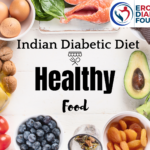People of all ages get affected by diabetes which is a chronic condition. To handle diabetes, your main focus should be on controlling your blood sugar levels. For the management of diabetes, a wholesome, balanced diet is essential. For people with different types of diabetes, this article will provide a diabetic diet food list. Additionally, it covers which foods a person should stay away from.
Why diet is important
Your food plays an important role in managing and preventing diabetes. You can enhance your health by filling your plate with delicious, well-balanced foods for both meals and snacks. It’s essential to consume food that lowers your risk of developing diabetes complications like heart disease, kidney failure etc.
Tip for good diabetes diet care
- Include more whole grains, vegetables, and fruits in your diet. These foods are high in fibre, which can help regulate blood sugar levels and improve insulin sensitivity.
- Drink a lot of water whenever you can to stay hydrated.
- Have tea or coffee with no sugar
- Rather than deep-frying it, grill your meat.
- Increase your consumption of lean foods like chicken and fish.
- Eat little meals every two hours. * Have dinner early.
Foods you should stay away
Knowing which foods to stay away from a diabetes diet is equally important as knowing which foods should be consumed. Foods you should avoid are as follows
- Alcohols
- Fried foods
- Refined grains
- Sweets (Candy, cookies etc.)
- Sugary drinks
- Processed meats
Sample menu plan
Here are a few sample menu plans with 50% carbohydrates, normal protein, and low fat for diabetes patients.
Menu Plan A:
Breakfast: 1 cup of cooked oats with 1/2 cup of mixed berries and 1 tablespoon of almond butter
Mid-morning snack: 1 small apple and 10 unsalted almonds
Lunch: 1 cup of brown rice, 1/2 cup of cooked lentils, 1 cup of mixed vegetables (carrots, beans, and cauliflower), and 1 small bowl of low-fat yoghurt
Mid-afternoon snack: 1 small banana and 1 tablespoon of peanut butter
Dinner: 1 small bowl of vegetable soup, 1 small bowl of mixed salad (lettuce, cucumber, and tomato), and 1 grilled chicken breast
Menu Plan B:
Breakfast: 2 slices of whole wheat bread with 1 boiled egg and 1 small bowl of mixed fruit salad
Mid-morning snack: 1 small orange and 10 unsalted pistachios
Lunch: 1 cup of quinoa, 1/2 cup of cooked chickpeas, 1 cup of mixed vegetables (broccoli, bell peppers, and zucchini), and 1 small bowl of low-fat yoghurt
Mid-afternoon snack: 1 small pear and 1 tablespoon of almond butter
Dinner: 1 small bowl of vegetable soup, 1 small bowl of mixed salad (lettuce, carrot, and beetroot), and 1 grilled fish fillet
Menu Plan C:
Breakfast: 1 cup of cooked brown rice with 1/2 cup of mixed vegetables (carrots, beans, and peas) and 1 boiled egg
Mid-morning snack: 1 small apple and 10 unsalted cashews
Lunch: 1 cup of whole wheat pasta with 1/2 cup of tomato sauce, 1 cup of mixed vegetables (mushrooms, bell peppers, and onions), and 1 small bowl of low-fat yoghurt
Mid-afternoon snack: 1 small banana and 1 tablespoon of peanut butter
Dinner: 1 small bowl of vegetable soup, 1 small bowl of mixed salad (lettuce, cucumber, and tomato), and 1 grilled chicken breast
These menu plans are just examples and should be customized based on the individual’s dietary needs and preferences. It is always recommended to consult a registered dietitian or a healthcare professional before making any significant changes to your diet.
To summarize
You may plan a healthy, balanced diet for diabetes using many ways. However, you should never forget that controlling your blood sugar levels is the primary goal of a diabetic diet. Thus, following the diabetic diet food list will lead you to a healthy life.


